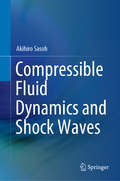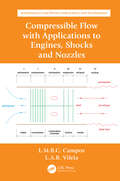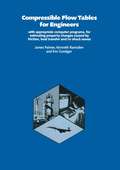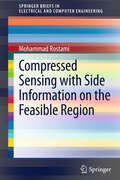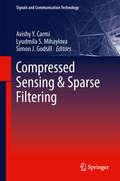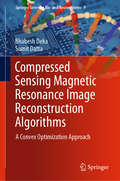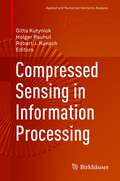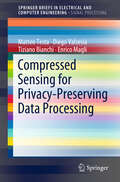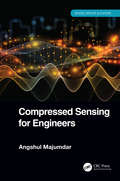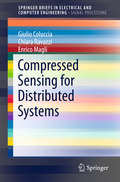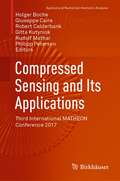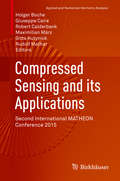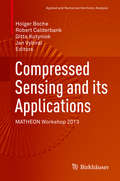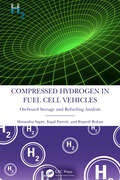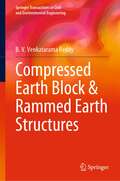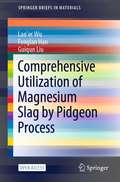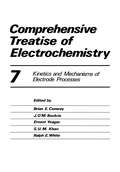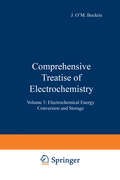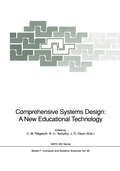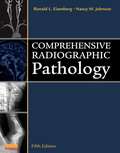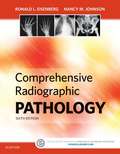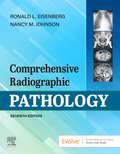- Table View
- List View
Compressible Fluid Dynamics and Shock Waves
by Akihiro SasohThis book offers comprehensive coverage of compressible flow phenomena and their applications, and is intended for undergraduate/graduate students, practicing professionals, and researchers interested in the topic. Thanks to the clear explanations provided of a wide range of basic principles, the equations and formulas presented here can be understood with only a basic grasp of mathematics.The book particularly focuses on shock waves, offering a unique approach to the derivation of shock wave relations from conservation relations in fluids together with a contact surface, slip line or surface; in addition, the thrust of a rocket engine and that of an air-breathing engine are also formulated. Furthermore, the book covers important fundamentals of various aspects of physical fluid dynamics and engineering, including one-dimensional unsteady flows, and two-dimensional flows, in which oblique shock waves and Prandtl-Meyer expansion can be observed.
Compressible Flow with Applications to Engines, Shocks and Nozzles (Mathematics and Physics for Science and Technology #11)
by Luis Manuel Braga da Costa Campos Luís António Raio VilelaCompressible Flow with Application to Shocks and Propulsion is part of the series "Mathematics and Physics for Science and Technology", which combines rigorous mathematics with general physical principles to model practical engineering systems with a detailed derivation and interpretation of results. Volume V presents the mathematical theory of partial differential equations and methods of solution satisfying initial and boundary conditions, and includes applications to: acoustic, elastic, water, electromagnetic and other waves; the diffusion of heat, mass and electricity; and their interactions. This is the second book of the volume. The first book of volume V starts with the classification of partial differential equations and proceeds with similarity methods that apply in general to linear equations with constant coefficients and all derivatives of the same order, such as the Laplace and Biharmonic equations, without and with forcing. The similarity solutions are also applied to Burger's non-linear diffusion equation. First-order linear and quasi-linear partial differential equations with variable coefficients are considered, with application to the representation of conservative/non-conservative, solenoidal/rotational and Beltrami/helical vector fields by one, two or three scalar and/or one vector potential in relation with exact, inexact and non-integrable differentials. The latter appear in the first and second principles of thermodynamics that specify the constitutive and diffusive properties of matter as concerns thermal, mechanical, elastic, flow, electrical, magnetic and chemical phenomena and their interactions. The book is intended for graduate students and engineers working with mathematical models and can be applied to problems in mechanical, aerospace, electrical and other branches of engineering dealing with advanced technology, and also in the physical sciences and applied mathematics. This book: Simultaneously covers rigorous mathematics, general physical principles and engineering applications with practical interest Provides interpretation of results with the help of illustrations Includes detailed proofs of all results L.M.B.C. Campos was chair professor and the Coordinator of the Scientific Area of Applied and Aerospace Mechanics in the Department of Mechanical Engineering and also the director (and founder) of the Center for Aeronautical and Space Science and Technology until retirement in 2020. L.A.R. Vilela is currently completing an Integrated Master's degree in Aerospace Engineering at Institute Superior Tecnico (1ST) of Lisbon University.
Compressible Flow with Applications to Engines, Shocks and Nozzles (Mathematics and Physics for Science and Technology #11)
by Luis Manuel Braga da Costa Campos Luís António Raio VilelaCompressible Flow with Application to Shocks and Propulsion is part of the series "Mathematics and Physics for Science and Technology", which combines rigorous mathematics with general physical principles to model practical engineering systems with a detailed derivation and interpretation of results. Volume V presents the mathematical theory of partial differential equations and methods of solution satisfying initial and boundary conditions, and includes applications to: acoustic, elastic, water, electromagnetic and other waves; the diffusion of heat, mass and electricity; and their interactions. This is the second book of the volume. The first book of volume V starts with the classification of partial differential equations and proceeds with similarity methods that apply in general to linear equations with constant coefficients and all derivatives of the same order, such as the Laplace and Biharmonic equations, without and with forcing. The similarity solutions are also applied to Burger's non-linear diffusion equation. First-order linear and quasi-linear partial differential equations with variable coefficients are considered, with application to the representation of conservative/non-conservative, solenoidal/rotational and Beltrami/helical vector fields by one, two or three scalar and/or one vector potential in relation with exact, inexact and non-integrable differentials. The latter appear in the first and second principles of thermodynamics that specify the constitutive and diffusive properties of matter as concerns thermal, mechanical, elastic, flow, electrical, magnetic and chemical phenomena and their interactions. The book is intended for graduate students and engineers working with mathematical models and can be applied to problems in mechanical, aerospace, electrical and other branches of engineering dealing with advanced technology, and also in the physical sciences and applied mathematics. This book: Simultaneously covers rigorous mathematics, general physical principles and engineering applications with practical interest Provides interpretation of results with the help of illustrations Includes detailed proofs of all results L.M.B.C. Campos was chair professor and the Coordinator of the Scientific Area of Applied and Aerospace Mechanics in the Department of Mechanical Engineering and also the director (and founder) of the Center for Aeronautical and Space Science and Technology until retirement in 2020. L.A.R. Vilela is currently completing an Integrated Master's degree in Aerospace Engineering at Institute Superior Tecnico (1ST) of Lisbon University.
Compressible Flow Tables for Engineers: With Appropriate Computer Programs, for Estimating Property Changes Caused by Friction Heat Transfer and/or Shock Waves (pdf)
by James Palmer K. W. Ramsden E. M. GoodgerCompressed Sensing with Side Information on the Feasible Region (SpringerBriefs in Electrical and Computer Engineering)
by Mohammad RostamiThis book discusses compressive sensing in the presence of side information. Compressive sensing is an emerging technique for efficiently acquiring and reconstructing a signal. Interesting instances of Compressive Sensing (CS) can occur when, apart from sparsity, side information is available about the source signals. The side information can be about the source structure, distribution, etc. Such cases can be viewed as extensions of the classical CS. In these cases we are interested in incorporating the side information to either improve the quality of the source reconstruction or decrease the number of samples required for accurate reconstruction. In this book we assume availability of side information about the feasible region. The main applications investigated are image deblurring for optical imaging, 3D surface reconstruction, and reconstructing spatiotemporally correlated sources. The author shows that the side information can be used to improve the quality of the reconstruction compared to the classic compressive sensing. The book will be of interest to all researchers working on compressive sensing, inverse problems, and image processing.
Compressed Sensing & Sparse Filtering (Signals and Communication Technology)
by Avishy Y. Carmi Lyudmila S. Mihaylova Simon J. GodsillThis book is aimed at presenting concepts, methods and algorithms ableto cope with undersampled and limited data. One such trend that recently gained popularity and to some extent revolutionised signal processing is compressed sensing. Compressed sensing builds upon the observation that many signals in nature are nearly sparse (or compressible, as they are normally referred to) in some domain, and consequently they can be reconstructed to within high accuracy from far fewer observations than traditionally held to be necessary. Apart from compressed sensing this book contains other related approaches. Each methodology has its own formalities for dealing with such problems. As an example, in the Bayesian approach, sparseness promoting priors such as Laplace and Cauchy are normally used for penalising improbable model variables, thus promoting low complexity solutions. Compressed sensing techniques and homotopy-type solutions, such as the LASSO, utilise l1-norm penalties for obtaining sparse solutions using fewer observations than conventionally needed. The book emphasizes on the role of sparsity as a machinery for promoting low complexity representations and likewise its connections to variable selection and dimensionality reduction in various engineering problems. This book is intended for researchers, academics and practitioners with interest in various aspects and applications of sparse signal processing.
Compressed Sensing Magnetic Resonance Image Reconstruction Algorithms: A Convex Optimization Approach (Springer Series on Bio- and Neurosystems #9)
by Bhabesh Deka Sumit DattaThis book presents a comprehensive review of the recent developments in fast L1-norm regularization-based compressed sensing (CS) magnetic resonance image reconstruction algorithms. Compressed sensing magnetic resonance imaging (CS-MRI) is able to reduce the scan time of MRI considerably as it is possible to reconstruct MR images from only a few measurements in the k-space; far below the requirements of the Nyquist sampling rate. L1-norm-based regularization problems can be solved efficiently using the state-of-the-art convex optimization techniques, which in general outperform the greedy techniques in terms of quality of reconstructions. Recently, fast convex optimization based reconstruction algorithms have been developed which are also able to achieve the benchmarks for the use of CS-MRI in clinical practice. This book enables graduate students, researchers, and medical practitioners working in the field of medical image processing, particularly in MRI to understand the need for the CS in MRI, and thereby how it could revolutionize the soft tissue imaging to benefit healthcare technology without making major changes in the existing scanner hardware. It would be particularly useful for researchers who have just entered into the exciting field of CS-MRI and would like to quickly go through the developments to date without diving into the detailed mathematical analysis. Finally, it also discusses recent trends and future research directions for implementation of CS-MRI in clinical practice, particularly in Bio- and Neuro-informatics applications.
Compressed Sensing in Information Processing (Applied and Numerical Harmonic Analysis)
by Gitta Kutyniok Holger Rauhut Robert J. KunschThis contributed volume showcases the most significant results obtained from the DFG Priority Program on Compressed Sensing in Information Processing. Topics considered revolve around timely aspects of compressed sensing with a special focus on applications, including compressed sensing-like approaches to deep learning; bilinear compressed sensing - efficiency, structure, and robustness; structured compressive sensing via neural network learning; compressed sensing for massive MIMO; and security of future communication and compressive sensing.
Compressed Sensing for Privacy-Preserving Data Processing (SpringerBriefs in Electrical and Computer Engineering)
by Matteo Testa Diego Valsesia Tiziano Bianchi Enrico MagliThe objective of this book is to provide the reader with a comprehensive survey of the topic compressed sensing in information retrieval and signal detection with privacy preserving functionality without compromising the performance of the embedding in terms of accuracy or computational efficiency. The reader is guided in exploring the topic by first establishing a shared knowledge about compressed sensing and how it is used nowadays. Then, clear models and definitions for its use as a cryptosystem and a privacy-preserving embedding are laid down, before tackling state-of-the-art results for both applications. The reader will conclude the book having learned that the current results in terms of security of compressed techniques allow it to be a very promising solution to many practical problems of interest. The book caters to a broad audience among researchers, scientists, or engineers with very diverse backgrounds, having interests in security, cryptography and privacy in information retrieval systems. Accompanying software is made available on the authors’ website to reproduce the experiments and techniques presented in the book. The only background required to the reader is a good knowledge of linear algebra, probability and information theory.
Compressed Sensing for Engineers (Devices, Circuits, and Systems)
by Angshul MajumdarCompressed Sensing (CS) in theory deals with the problem of recovering a sparse signal from an under-determined system of linear equations. The topic is of immense practical significance since all naturally occurring signals can be sparsely represented in some domain. In recent years, CS has helped reduce scan time in Magnetic Resonance Imaging (making scans more feasible for pediatric and geriatric subjects) and has also helped reduce the health hazard in X-Ray Computed CT. This book is a valuable resource suitable for an engineering student in signal processing and requires a basic understanding of signal processing and linear algebra. Covers fundamental concepts of compressed sensing Makes subject matter accessible for engineers of various levels Focuses on algorithms including group-sparsity and row-sparsity, as well as applications to computational imaging, medical imaging, biomedical signal processing, and machine learning Includes MATLAB examples for further development
Compressed Sensing for Engineers (Devices, Circuits, and Systems)
by Angshul MajumdarCompressed Sensing (CS) in theory deals with the problem of recovering a sparse signal from an under-determined system of linear equations. The topic is of immense practical significance since all naturally occurring signals can be sparsely represented in some domain. In recent years, CS has helped reduce scan time in Magnetic Resonance Imaging (making scans more feasible for pediatric and geriatric subjects) and has also helped reduce the health hazard in X-Ray Computed CT. This book is a valuable resource suitable for an engineering student in signal processing and requires a basic understanding of signal processing and linear algebra. Covers fundamental concepts of compressed sensing Makes subject matter accessible for engineers of various levels Focuses on algorithms including group-sparsity and row-sparsity, as well as applications to computational imaging, medical imaging, biomedical signal processing, and machine learning Includes MATLAB examples for further development
Compressed Sensing for Distributed Systems (SpringerBriefs in Electrical and Computer Engineering)
by Giulio Coluccia Chiara Ravazzi Enrico MagliThis book presents a survey of the state-of-the art in the exciting and timely topic of compressed sensing for distributed systems. It has to be noted that, while compressed sensing has been studied for some time now, its distributed applications are relatively new. Remarkably, such applications are ideally suited to exploit all the benefits that compressed sensing can provide. The objective of this book is to provide the reader with a comprehensive survey of this topic, from the basic concepts to different classes of centralized and distributed reconstruction algorithms, as well as a comparison of these techniques. This book collects different contributions on these aspects. It presents the underlying theory in a complete and unified way for the first time, presenting various signal models and their use cases. It contains a theoretical part collecting latest results in rate-distortion analysis of distributed compressed sensing, as well as practical implementations of algorithms obtaining performance close to the theoretical bounds. It presents and discusses various distributed reconstruction algorithms, summarizing the theoretical reconstruction guarantees and providing a comparative analysis of their performance and complexity. In summary, this book will allow the reader to get started in the field of distributed compressed sensing from theory to practice. We believe that this book can find a broad audience among researchers, scientists, or engineers with very diverse backgrounds, having interests in mathematical optimization, network systems, graph theoretical methods, linear systems, stochastic systems, and randomized algorithms. To help the reader become familiar with the theory and algorithms presented, accompanying software is made available on the authors’ web site, implementing several of the algorithms described in the book. The only background required of the reader is a good knowledge of advanced calculus and linear algebra.
Compressed Sensing and Its Applications: Third International MATHEON Conference 2017 (Applied and Numerical Harmonic Analysis)
by Holger Boche Giuseppe Caire Robert Calderbank Gitta Kutyniok Rudolf Mathar Philipp PetersenThe chapters in this volume highlight the state-of-the-art of compressed sensing and are based on talks given at the third international MATHEON conference on the same topic, held from December 4-8, 2017 at the Technical University in Berlin. In addition to methods in compressed sensing, chapters provide insights into cutting edge applications of deep learning in data science, highlighting the overlapping ideas and methods that connect the fields of compressed sensing and deep learning. Specific topics covered include:Quantized compressed sensingClassificationMachine learningOracle inequalitiesNon-convex optimizationImage reconstructionStatistical learning theoryThis volume will be a valuable resource for graduate students and researchers in the areas of mathematics, computer science, and engineering, as well as other applied scientists exploring potential applications of compressed sensing.
Compressed Sensing and its Applications: Second International MATHEON Conference 2015 (Applied and Numerical Harmonic Analysis)
by Holger Boche Giuseppe Caire Robert Calderbank Maximilian März Gitta Kutyniok Rudolf MatharThis contributed volume contains articles written by the plenary and invited speakers from the second international MATHEON Workshop 2015 that focus on applications of compressed sensing. Article authors address their techniques for solving the problems of compressed sensing, as well as connections to related areas like detecting community-like structures in graphs, curbatures on Grassmanians, and randomized tensor train singular value decompositions. Some of the novel applications covered include dimensionality reduction, information theory, random matrices, sparse approximation, and sparse recovery. This book is aimed at both graduate students and researchers in the areas of applied mathematics, computer science, and engineering, as well as other applied scientists exploring the potential applications for the novel methodology of compressed sensing. An introduction to the subject of compressed sensing is also provided for researchers interested in the field who are not as familiar with it.
Compressed Sensing and its Applications: MATHEON Workshop 2013 (Applied and Numerical Harmonic Analysis)
by Holger Boche Robert Calderbank Gitta Kutyniok Jan VybíralSince publication of the initial papers in 2006, compressed sensing has captured the imagination of the international signal processing community, and the mathematical foundations are nowadays quite well understood.Parallel to the progress in mathematics, the potential applications of compressed sensing have been explored by many international groups of, in particular, engineers and applied mathematicians, achieving very promising advances in various areas such as communication theory, imaging sciences, optics, radar technology, sensor networks, or tomography.Since many applications have reached a mature state, the research center MATHEON in Berlin focusing on "Mathematics for Key Technologies", invited leading researchers on applications of compressed sensing from mathematics, computer science, and engineering to the "MATHEON Workshop 2013: Compressed Sensing and its Applications” in December 2013. It was the first workshop specifically focusing on the applications of compressed sensing. This book features contributions by the plenary and invited speakers of this workshop. To make this book accessible for those unfamiliar with compressed sensing, the book will not only contain chapters on various applications of compressed sensing written by plenary and invited speakers, but will also provide a general introduction into compressed sensing.The book is aimed at both graduate students and researchers in the areas of applied mathematics, computer science, and engineering as well as other applied scientists interested in the potential and applications of the novel methodology of compressed sensing. For those readers who are not already familiar with compressed sensing, an introduction to the basics of this theory will be included.
Compressed Hydrogen in Fuel Cell Vehicles: On-board Storage and Refueling Analysis
by Shitanshu Sapre Kapil Pareek Rupesh RohanThis book highlights the challenges of using hydrogen as a fuel for sustainable transportation including introduction of various hydrogen storage technologies, storage requirement for fuel cell vehicles, compressed hydrogen storage system, and refueling analysis with thermal management. Furthermore, thermodynamics and kinetics involved during refuelling, heat transfer issues in storage tank and effect of severe operating conditions on structure of storage tank under SAEJ2601 refueling conditions are discussed in detail. Features: Covers design and analysis of on-board storage/tank for compressed hydrogen in fuel-cell vehicle applications. Discuss heat transfer issues and effect of severe operating conditions on structure of storage the tank. Includes the structural analysis of composite storage tank. Provides assessment on refueling process of compressed hydrogen storage system and novel refueling process. Deals with thermodynamic and kinetic involved during refueling as per SAEJ2601. This book aims at researchers, professionals, and graduate students in automotive engineering, energy and power, materials, and chemical engineering.
Compressed Hydrogen in Fuel Cell Vehicles: On-board Storage and Refueling Analysis
by Shitanshu Sapre Kapil Pareek Rupesh RohanThis book highlights the challenges of using hydrogen as a fuel for sustainable transportation including introduction of various hydrogen storage technologies, storage requirement for fuel cell vehicles, compressed hydrogen storage system, and refueling analysis with thermal management. Furthermore, thermodynamics and kinetics involved during refuelling, heat transfer issues in storage tank and effect of severe operating conditions on structure of storage tank under SAEJ2601 refueling conditions are discussed in detail. Features: Covers design and analysis of on-board storage/tank for compressed hydrogen in fuel-cell vehicle applications. Discuss heat transfer issues and effect of severe operating conditions on structure of storage the tank. Includes the structural analysis of composite storage tank. Provides assessment on refueling process of compressed hydrogen storage system and novel refueling process. Deals with thermodynamic and kinetic involved during refueling as per SAEJ2601. This book aims at researchers, professionals, and graduate students in automotive engineering, energy and power, materials, and chemical engineering.
Compressed Earth Block & Rammed Earth Structures (Springer Transactions in Civil and Environmental Engineering)
by B. V. ReddyThe book focuses on low carbon construction materials such as stabilised compressed earth blocks (CEB’s) and rammed earth (RE). The content has been divided into four broad themes which includes an introduction to earth construction & stabilised earth, stabilised compressed earth blocks and masonry, stabilised rammed earth, and energy, carbon emissions, sustainability and case studies. It provides basic introduction to earthen materials and earthen structures, particularly with reference to the contemporary work on stabilised earth products for structural applications in buildings. The illustrations in the form of graphs, tables and photographs help the reader to get a grip over the CEB and RE construction. The book illustrates many case studies and examples of CEB and RE buildings. The knowledge on structural characteristics of CEB and RE especially with reference to the durability of such earthen products, and the structural design aspects is uniquely dealt. The embodied energy, embodied carbon, and the impact on construction sector touching upon sustainability of buildings is another unique feature of the book. This volume will be a useful guide for the research community, teachers, engineers, architects, building professionals, practicing engineers, students and individuals aspiring to build low carbon and sustainable buildings.
Comprehensive Utilization of Magnesium Slag by Pidgeon Process (SpringerBriefs in Materials)
by Fenglan Han Lan'er Wu Guiqun LiuThis open access book introduces the harmless handling/recycling of magnesium slag , the process of magnesium silicothermic reduction (Pidgeon process)which the slag was produced, and . the magnesium resources, layout of the industry of the world. Examples and experimental data in this book are from the author group’s research programs, as well as the rencent researches in China. The book could provide precious reference to scientists and engineers in the field of recycling and environment friendly use of the industrial solid wastes. It could also be used for researchers and students who are interested in relevant field.
Comprehensive Treatise of Electrochemistry: Volume 7 Kinetics and Mechanisms of Electrode Processes (pdf) (Comprehensive Treatise Of Electrochemistry Ser. #Vol. 3)
by Peter Horsman Brian E. Conway E. YeagerComprehensive Treatise of Electrochemistry: Volume 3: Electrochemical Energy Conversion and Storage
by Peter Horsman Brian E. Conway E. YeagerIt is now time for a comprehensive treatise to look at the whole field of electrochemistry. The present treatise was conceived in 1974, and the earliest invitations to authors for contributions were made in 1975. The completion of the early volumes has been delayed by various factors. There has been no attempt to make each article emphasize the most recent situation at the expense of an overall statement of the modern view. This treatise is not a collection of articles from Recent Advances in Electrochemistry or Modern Aspects of Electrochemistry. It is an attempt at making a mature statement about the present position in the vast area of what is best looked at as a new interdisciplinary field. Texas A & M University J. O'M. Bockris University of Ottawa B. E. Conway Case Western Reserve University Ernest Yeager Texas A & M University Ralph E. White Preface to Volume 3 Of events which have affected progress in the field of electrochemistry, the decision of NASA to use electrochemical auxiliary power in space vehicles was one of the more important. Another important decision was Ford's announcement of their sodium-sulfur cell for vehicular use in 1969.
Comprehensive Systems Design: Proceedings of the NATO Advanced Research Workshop on Comprehensive Systems Design: A New Educational Technology, held in Pacific Grove, California, December 2–7, 1990 (NATO ASI Subseries F: #95)
by Charles M. Reigeluth Bela H. Banathy J. R. OlsonEducational technology in the broadest sense is knowledge and competence forimproving the educational process: for using hardware (equipment), software (methods), and "underware" (underlying organizational structures). This volume in the Special Programme on Advanced Educational Technology presents the results of a NATO Advanced Research Workshop on educational systems design as a new educational technology. The objective of the workshop was toadvance our knowledge about the comprehensive systems design approach for improving educational systems. The workshop was organized for the transdisciplinary interaction of three scientific groups representing design science, organizational/systems science, and educationaltechnology. Participants were selected based on their scholarship as members of one or more of these three groups. The book opens with theframing papers sent by the editors to participants prior to the workshop, then presents five sets of thematic contributions: the conceptual and empirical contexts of comprehensive systems design, the systems design focus, a systems view of designing educational systems, the educational context of systems design, and high technology focus in systems design.
Comprehensive Radiographic Pathology - E-Book
by Ronald L. Eisenberg Nancy M. JohnsonCovering the disease processes most frequently diagnosed with medical imaging, Comprehensive Radiographic Pathology, 5th Edition provides the essential pathology knowledge needed to produce quality radiographic images. It includes a general overview of physiology, and covers disorders and injuries by body system with descriptions of the pathology, its radiographic appearance, and treatment. Now in full color, this reference includes the latest information on CT, MRI, SPECT, PET, ultrasound, and nuclear medicine, plus the always-popular Radiographer Notes with tips for digital imaging and patient care. Expert authors Ronald L. Eisenberg and Nancy M. Johnson provide complete preparation for the classroom and for clinical practice!Comprehensive coverage helps you produce optimal images by understanding disease processes and their radiographic appearance.High-quality radiographs and images clearly demonstrate the clinical manifestations of different disease processes and represent the quality images needed in radiography practice.A body systems approach makes it easy to locate and study information, with each chapter describing general physiology and then explaining various pathologic conditions and their radiographic appearance and treatment.A discussion of specialized imaging techniques includes the full range of imaging modalities that may be needed to ensure correct diagnosis of pathologies, including ultrasound, computed tomography, magnetic resonance imaging, nuclear medicine, single-photon emission computed tomography (SPECT), or positron emission tomography (PET).Treatment sections explain the most likely treatment for each pathology along with its prognosisRadiographer Notes include tips for producing optimal radiographs along with patient management recommendations.Summary Findings tables offer a quick reference to related pathologies, including location in the body, radiographic appearances, and treatments.Study aids include an outline, key terms, objectives, and review questions for every chapter.Useful appendices include an extensive glossary, list of major prefixes, roots, and suffixes with definitions and examples. Updated content prepares you for today's practice with the latest on morbidity, mortality, and epidemiology; invasive squamous cell carcinoma; scoliosis; joint replacements; chest tubes and lines; MRSA (antibiotic-resistant staph infection); systemic and highly infectious diseases; more on fusion imaging, CT, MRI, SPECT, PET and correlation with radiography; new CT/MR images for correlation with radiographs; and Radiographer Notes updated with digital imaging information. NEW full-color illustrations are added, and updated images add realistic detail for MRI, CT, sonography, and fusion PET/CT. NEW Mosby's Radiography Online: Radiographic Pathology course enhances your understanding with interactive learning including animations, video clips, and narrated slide shows.
Comprehensive Radiographic Pathology - E-Book
by Ronald L. Eisenberg Nancy M. JohnsonGain the essential pathology understanding you need to produce quality radiographic images! Covering the disease processes most frequently diagnosed with medical imaging, Comprehensive Radiographic Pathology, 6th Edition is the perfect pathology resource for acquiring a better understanding of the clinical manifestation of different disease processes, their radiographic appearances, and their treatments. This full-color reference begins with a general overview of physiology, then covers disorders and injuries by body system. The new edition also includes the latest information on CT, MRI, SPECT, PET, ultrasound, and nuclear medicine — including updated radiographer notes, images, and review questions.Thorough explanations and comprehensive coverage aid readers’ understanding of disease processes and their radiographic appearance. Numerous high-quality illustrations covering all modalities clearly demonstrate the clinical manifestations of different disease processes and provide readers with a standard for the high-quality images needed in radiography practice.Discussion of specialized imaging explains how supplemental modalities, such as ultrasound, computed tomography, magnetic resonance imaging, nuclear medicine, single-photon emission computed tomography (SPECT), and positron emission tomography (PET) are sometimes needed to diagnose various pathologies. Treatment coverage provides readers with brief explanations of the most likely treatments and the prognosis for each pathology. Systems-based approach organizes the pathology of various body systems in separate chapters — each chapter provides an initial discussion of general physiology and then explains various pathologic conditions and their radiographic appearance and treatment. Summary Findings tables are a great quick reference guide for practitioners.Consistent organization aids readers in searching for information.Study aids include an outline, key terms, objectives, and review questions for every chapter.Useful appendices include an extensive glossary; a list of major prefixes, roots, and suffixes with definitions and examples; and a table of diagnostic implications of abnormal lab values.NEW! Updated images in all modalities keep readers abreast on the latest advances needed for clinical success.NEW! Updated chapter review questions have been added to the end of every chapter.NEW! Additional review questions on Evolve companion site provide students with extra resources to prepare for certification.NEW! Updated radiographer notes incorporate current digital imaging information for both computed radiography and direct digital capture.
Comprehensive Radiographic Pathology E-Book
by Ronald L. Eisenberg Nancy M. JohnsonGet the perfect level of pathology coverage to help you learn how to consistently produce quality radiographic images with Comprehensive Radiographic Pathology, 7th Edition. This full-color text provides a foundation in the basic principles of pathology and then focuses on the radiographic appearances of diseases and injuries that are most likely to be diagnosed with medical imaging. Understanding these disease processes, the radiographic appearances, and the treatments is necessary for technologists to fully contribute to the functioning of the diagnostic team, and this text is the perfect way to ground yourself in all three of these areas. Enhancements to this new edition include updated images in all modalities, content aligned to the latest ARRT Guidelines, updated Radiographer Notes, and the inclusion of some pediatric pathologies.Thorough explanations help you select proper modalities and producing optimal images.Hundreds of high-quality illustrations covering all modalities clearly demonstrate clinical manifestations of different disease processes and provide a standard for the high-quality images needed in radiography practice.Discussion of specialized imaging explains how supplemental modalities, such as ultrasound, computed tomography, magnetic resonance imaging, nuclear medicine, single-photon emission computed tomography (SPECT), and positron emission tomography (PET) are sometimes needed to diagnose various pathologies.Brief explanations of likely treatments provide valuable background.Systems-based approach for building an understanding of pathology makes it easy for you to locate information and study one area at a time.NEW! Updated images in all modalities provides the important information needed for clinical success.NEW! Updated content matches the latest ARRT Guidelines to assist you in preparing for boards.NEW! Updated Radiographer Notes incorporate current digital imaging information for both computed radiography and direct digital capture.NEW! Inclusion of certain pediatric pathologies expands your comfort level with child and adolescent patients.
